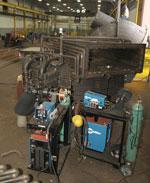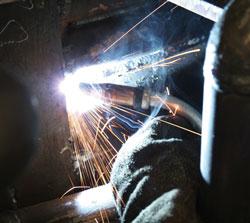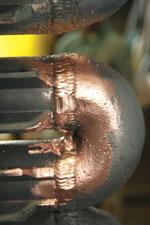- FMA
- The Fabricator
- FABTECH
- Canadian Metalworking
Categories
- Additive Manufacturing
- Aluminum Welding
- Arc Welding
- Assembly and Joining
- Automation and Robotics
- Bending and Forming
- Consumables
- Cutting and Weld Prep
- Electric Vehicles
- En Español
- Finishing
- Hydroforming
- Laser Cutting
- Laser Welding
- Machining
- Manufacturing Software
- Materials Handling
- Metals/Materials
- Oxyfuel Cutting
- Plasma Cutting
- Power Tools
- Punching and Other Holemaking
- Roll Forming
- Safety
- Sawing
- Shearing
- Shop Management
- Testing and Measuring
- Tube and Pipe Fabrication
- Tube and Pipe Production
- Waterjet Cutting
Industry Directory
Webcasts
Podcasts
FAB 40
Advertise
Subscribe
Account Login
Search
Pulse welding eases exotic-metal fabrication
Furnace fabricator pulse welds copper, aluminum-bronze
- December 14, 2008
- Article
- Arc Welding
Fundamentally, steelmaking electric arc furnaces transfer energy—lots of it. Used at mini-mills throughout the world, the furnaces' graphite electrodes melt metal scrap and burn out chemical impurities. And water-cooled pipes are central to the design. The better they transfer heat and electricity to where they're needed within the extreme conditions of a furnace, the more efficient the furnace operation becomes.
Improving such efficiency is how AmeriFab Inc. built a business.
Founded in 1992, the company is one of the few that not only engineers and sells its steel mill products, but manufactures them as well. And it all happens on a 6-acre campus just southwest of downtown Indianapolis, where 70 employees work in about 80,000 square feet of manufacturing space.
Modern electric arc and basic oxygen furnaces put extreme thermal loads on components, including those water-cooled pipes (see Figures 1 and 2). As an alternative, the company offers a patent-pending, extruded aluminum-bronze pipe for water-cooled ductwork with heat-transfer characteristics that exceed those of normal steel. It resists acidic attack while reducing the chance of thermal cracking, and it also extends periods between scheduled maintenance shutdowns. The company also offers water-cooled copper components, such as furnace side walls and roof panels.
AmeriFab designers chose aluminum-bronze and copper for pipe designs so the end product could endure extreme conditions and, ultimately, meet the industry's never-ending quest for more power (that is, more current sent into the furnace electrodes) and less downtime. But the materials did create problems for Tom Vincent, lead welder, and his team, who deposit a sizable amount of weld metal a day on workpieces weighing thousands of pounds. When welders used gas metal arc welding in either short-circuit or conventional spray-transfer mode, problems emerged.
Vincent explained how, with conventional GMAW, the aluminum-bronze weld pool became so fluid, it was like water. "It drips," he said, "and that makes it hard to carry the puddle [welding] uphill."
Regarding copper, "the hard part … is keeping the puddle clean," Vincent said. "The molten copper picks up scale from the puddle and the welding wire. Even with clean metal and filler wire, a copper carbide scale forms on top of the puddle. We can't weld over the top of the scale, because that creates impurities in the weld."
Using spray transfer, welders needed either to take the time to move the parts to make welds in the flat or horizontal position, or use the slower but cooler short-circuit transfer process to weld out-of-position, not an attractive option considering the volume of material in the weld shop. But sometimes it was simply unavoidable. The complex geometry of pipe welding usually demanded welding out-of-position, and most procedures specified welding vertical-up to ensure complete fusion and prevent cold lap (see Figure 3).
Eyeing the Pulse
AmeriFab uses copper and aluminum-bronze for their high thermal conductivity, but the same thermal conductivity also creates welding challenges. GMAW sends a concentrated arc into the joint, but because the materials have such high thermal conductivity, heat is hard to control. This, among other things, promotes distortion and a very fluid, hard-to-control weld pool.
In this situation, another welding process can offer distinct advantages. Pulsed GMAW (GMAW-P), a process said to give more control over the welding arc and weld pool, uses a pulsing current with high and low peaks superimposed over a constant-voltage background current. The peak pulse provides the penetration, but it quickly gets out of the way as the background current—set so that no metal transfer occurs—takes over. The combination, the theory goes, gives the best of both worlds: greater penetration without excess heat.

CLICK ON IMAGE FOR LARGER VIEWFigure 1 This operator uses a GMAW-P to weld the cooling system for the lid of an electric arc furnace.
This pulse-background current combination has been said to give pulse welding a leg up over conventional GMAW. For instance, compared to short-circuit transfer, GMAW-P offers faster travel speeds, higher deposition rates, and less spatter. And compared to conventional spray transfer, pulsed welding produces less distortion and allows for all-position welding.
For some time AmeriFab, like many high-volume fabricators and manufacturers, eyed GMAW-P from a distance and stayed with its tried-and-true welding processes. Pulsed technology was still a developing process with significant drawbacks.
As AmeriFab's Rick Manasek explained, "In the past it was difficult to be consistent and to train people using the pulsed MIG [GMAW] controls. Providers talked about these synergic controls and so forth. They weren't very operator-friendly, and I think it discouraged people from using them."
When introducing pulsed GMAW to operators whose personal comfort zone and experience are with traditional gas metal arc or flux-cored welding technology, the greatest obstacles have been arc length and arc control. In the past the limits of available pulsing technology forced operators to weld with a longer arc length to help prevent short circuits (wire stubbing), resulting in spatter. Longer arc lengths of about ¾ in. make it more difficult to control the weld pool. (Imagine trying to slowly push a billiard ball around with a pool cue; the shorter the cue, the easier it is to do.) Longer arc lengths also tend to produce undercut if travel speeds are not reduced to compensate, which in turn leads to overwelding.
The technology, however, has changed, which spurred AmeriFab finally to adopt the new process (see Figure 4). Today, for instance, machines offer simplified controls. For example, Miller Electric's Accu-Pulse®—the pulsed technology AmeriFab invested in—has three adjustable controls: wire feed speed, arc length, and arc cone width. The technology enables operators to adjust the arc length to one that meets their personal preference (generally between 3⁄8 and ½ in.), regardless of electrode stick-out. The system produces a more focused arc column, so operators have control over the weld pool. They also can adjust the width of the arc column—operators can use a narrow arc column for deep joints or inside corners, and a wide column for cover passes or to catch both sides of the joint.
The Importance of Training
Several years ago AmeriFab began replacing its older machines with those having pulsed welding capability. Managers first offered the new systems to experienced operators welding the toughest jobs. Vincent then worked with this select group in a designated training area until they were comfortable with the equipment. Training typically took one to two weeks.
"Proper training is the key to success when introducing new equipment and technology," said Manasek. "If I put you behind the wheel of an Indy car and you don't know which buttons to push, you're not going to get off the starting line."
As of November 2007, the company had put 14 new pulsed welding systems into operation in three different buildings, two of which are off-site from the headquarters facility. To ensure consistency between locations, Vincent uses his Palm OS-based hand-held as a file-management tool.
"I use my Palm to download the same pulsing programs to all 14 machines and lock the operators out of the program," he explained. "I give them recommended parameters for wire feed speed, arc [length], and arc [cone width]. They can change those parameters to suit their preference, but they can't accidentally delete the program or change the waveform."
If Vincent wanted to, he could use his Palm to control parameters more closely by giving operators a limited window of adjustment for wire feed speed, arc cone width, and arc length.

CLICK ON IMAGE FOR LARGER VIEWFigure 3 The complex geometry of pipe welding often requires AmeriFab's workers to weld out-of-position.
Some Pulsed, Some Conventional
AmeriFab doesn't use pulsed welding exclusively. Instead, the company matches the process with the application. For the brunt of its carbon steel welds (of which there are many), welders still use conventional GMAW, while GMAW-P dominates certain pipe and other ductwork applications. With the new process came productivity improvements of between 15 and 20 percent. The pulse process also means Vincent no longer has to deal with those dripping weld pools in aluminum-bronze.
As Vincent put it, "I've always said that pulsed MIG was made for welding aluminum-bronze."
Related Companies
subscribe now

The Fabricator is North America's leading magazine for the metal forming and fabricating industry. The magazine delivers the news, technical articles, and case histories that enable fabricators to do their jobs more efficiently. The Fabricator has served the industry since 1970.
start your free subscription- Stay connected from anywhere

Easily access valuable industry resources now with full access to the digital edition of The Fabricator.

Easily access valuable industry resources now with full access to the digital edition of The Welder.

Easily access valuable industry resources now with full access to the digital edition of The Tube and Pipe Journal.
- Podcasting
- Podcast:
- The Fabricator Podcast
- Published:
- 04/16/2024
- Running Time:
- 63:29
In this episode of The Fabricator Podcast, Caleb Chamberlain, co-founder and CEO of OSH Cut, discusses his company’s...
- Industry Events
16th Annual Safety Conference
- April 30 - May 1, 2024
- Elgin,
Pipe and Tube Conference
- May 21 - 22, 2024
- Omaha, NE
World-Class Roll Forming Workshop
- June 5 - 6, 2024
- Louisville, KY
Advanced Laser Application Workshop
- June 25 - 27, 2024
- Novi, MI

































